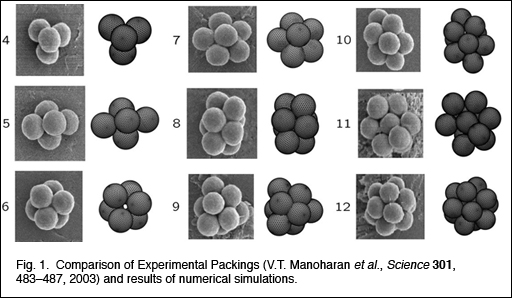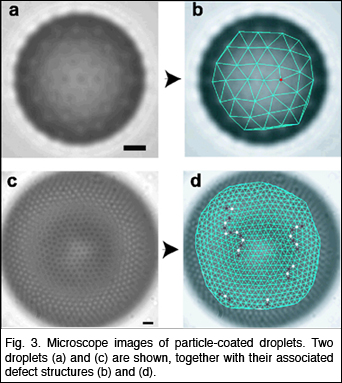




| IRG III – INTERFACE-MEDIATED ASSEMBLY of SOFT MATERIALS | |
| Coordinator: Michael P. Brenner | |
| Michael P. Brenner (DEAS) David R. Nelson (Physics, DEAS) David R. Reichman (Chemistry) |
Howard A. Stone (DEAS) |
Collaborators: David A. Edwards
(Harvard, Alkermes) and Ian Morrison (Cabot) |
|
The goal of this IRG is to investigate the self-assembly of structures that are guided by surfaces. Considerable progress was made investigating the structure of colloidal particles on the surfaces of fluid droplets. Weitz and Stone investigated the behavior of droplets with particles on their surfaces experimentally, while Brenner and Nelson investigated their behavior theoretically. The packing of particles on the surfaces of droplets in equilibrium and during drying was investigated. These results provide the required insight to allow the fabrication of new structures comprised of particle-coated droplets. In addition, Stone and Weitz, in collaboration with Whitesides, developed novel microfluidic methods to create complex droplet structures. The IRG will continue to combine microfluidic development of new structures using fluid droplets with the study of the interfaces of these droplets. Considerable effort will be devoted to the drying properties of these drops, and the consequences of the colloidal particles on this drying. Stone and Weitz have developed a qualitatively new route to control and manipulate individual droplets within microfluidic devices. In this approach, emulsions are made drop-by-drop in microfluidic devices and then precisely broken either by placing obstacles in the channel, or in the extensional flow of a T-junction. Both of these techniques are passive, requiring no moving parts. The advantage of passive breakup at a T-junction is that by controlling the relative lengths of the side arms, the relative volumes of the daughter droplets can be controlled with a high degree of precision. The alternative obstacle mediated passive breakup has the advantage that it requires less space on the device and also that it can be used to break a precise select fraction of the droplets, such as every second or every third droplet; the disadvantage here is that the relative sizes of the daughter drops are not precisely set. This work will continue through the incorporation of these droplets in more complex microfluidic devices that will allow the simultaneous production, recombination and sorting of droplets, and that will incorporate the production of even more complex droplet structures. Brenner is investigating improved
methods for creating droplets. The production of small fluid droplets
relies on an instability of solutions to the Young-Laplace equation.
He is investigating the dependence of this instability on the boundary.
He found that at a given critical pressure, the circular nozzle actually
produces the largest droplet, and that the droplet volume can be
decreased by up to 21% using a triangular nozzle with stretched corners. Brenner has
also initiated an inter-MRSEC collaboration, working with Pine from
the UCSB MRSEC. He is interpreting the results of recent experiments
which demonstrate that evaporating liquid droplets with identical
interfacial colloidal particles create unique packings of spheres.
He has carried out numerical simulations of this process, reproducing
the experimental results (Fig. 1). Additionally, he has invented a theoretical framework for understanding how the final packings are generated, and why and when they are unique. He plans next to investigate the inverse question: How can the final structure be tuned by controlling the properties of the particles, such as their wetting behavior. These results may provide simple methods for fabricating novel building blocks for self-assembly. Brenner has also collaborated with Weitz to study gels made by inducing attractive short-range forces between small silica beads (10 nm) in a dilute solution, which show surprising behavior. After the gel is formed the shear modulus increases by several orders of magnitude over tens of hours. They showed that this aging behavior was due to an increase in the intrinsic modulus of the gel, rather than a restructuring. Brenner developed a model to calculate typical time scales for a surface-tension induced sintering process that can exist in this system and gives rise to the increase in the elastic modulus. Due to the weak solubility of silica in water sintering is neglected for typical colloids, but the large surface tension forces between nano-particles causes it to be relevant in this case. Nelson and Weitz collaborated
on a study of the nature of the patterns that form when repulsive
particles order on the spherical surfaces. The origin of this problem
dates back nearly 100 years, when J.J. Thomson was investigating
the packing of electrons in an atom before the developments of quantum
mechanics. He attempted to determine the structure of the repulsive
electrons modeled to be on the surface of a sphere, and discovered
that this was a difficult problem. This problem has remained unsolved
to this day, when the number of size of the particles is considerably
smaller than the size of the sphere, so that there are a large number
of repulsive particles on the sphere’s surface. Stone investigated bubble rearrangements in foams, and made some of the first measurements of the local bubble-scale rearrangments, identified frequently as the T1-process. He constructed a viscous flow model to explain how the time-scale of this microstructural rearrangment is impacted by the surface rheology and kinetics of the surfactants that make up the foam. Experiments with different surfactants systems suggest that the long time scale seen when microstructural rearrangements occur is a consequence of kinetic limitations on the re-equilibration of the surface, rather than being associated with any direct viscous processes, since the rearrangements rapidly create new interfacial area which must equilibrate with the bulk surfactant. He examined the initial stages of bubble formation during a shearing process, since simple mechanical actions such as washing and scrubbing lead to foams and little is understood about the details of the dynamics or chemistry important for the characteristics of the resultant foam. Stone will continue his investigation of bubble dynamics in foams. He will also continue to develop a new project investigating the formation of thin film on fibers drawn from a colloidal suspension. He finds that the colloids tend to form unexpected bands, and he will investigate the origin of these. This work will be closely coordinated with further studies on the particle-coated droplets that Weitz is conducting, and that Brenner, Nelson and Reichman are investigating theoretically. |
|
Last Modified April 27, 2004.

 Weitz and Nelson studied
the behavior of colloidal particles at the surface of emulsion droplets;
provided the particles are stable, there is long-range repulsion
between them. This is an equilibrated system that allows them to
investigate the solution to this problem experimentally, and these
results can be compared to theoretical expectations. They find that
as the size of the sphere increases, new defects develop in the packing
of the colloidal particles on the surface of the sphere. These take
the form of pairs of 5-fold and 7-fold coordinated particles, aligned
in a linear pattern, which they label as “scars.” These
are similar to grain boundaries in packings on 2-D surfaces, but
because of the curvature of the sphere, these grain boundaries do
not extend all the way to the end of the crystallites. Theoretical
calculations which consider the effective elastic interaction of
the particles and focus on the arrangement of the defects do agree
quite well with these observations.
Weitz and Nelson studied
the behavior of colloidal particles at the surface of emulsion droplets;
provided the particles are stable, there is long-range repulsion
between them. This is an equilibrated system that allows them to
investigate the solution to this problem experimentally, and these
results can be compared to theoretical expectations. They find that
as the size of the sphere increases, new defects develop in the packing
of the colloidal particles on the surface of the sphere. These take
the form of pairs of 5-fold and 7-fold coordinated particles, aligned
in a linear pattern, which they label as “scars.” These
are similar to grain boundaries in packings on 2-D surfaces, but
because of the curvature of the sphere, these grain boundaries do
not extend all the way to the end of the crystallites. Theoretical
calculations which consider the effective elastic interaction of
the particles and focus on the arrangement of the defects do agree
quite well with these observations. 